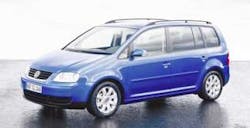VW leads in laser welding activity
Sturbridge, MA—A presentation made by Volkswagen at the Laser Congress, held in conjunction with Laser Munich last June, seems to have created a stir among those interested in laser usage in the automobile industry. This presentation was the hot topic on the floor of the Laser Fair and afterwards it showed up in a commentary in at least one publication. In essence the vibrations on the show floor and comments in a British publication were that VW had turned negative on solid-state laser processing for future body applications in the 2015 and beyond timeframe.
Industrial Laser Solutions was able to obtain a copy of the Power Point presentation made in Munich and finds that the conclusions and perceptions attributed to VW were not completely accurate.
What was said in this presentation is that VW will have about 490 high-power CW Nd:YAG lasers installed for body-in-white assembly applications by the end of this year—up from just 10 installed in 1995 and about three times the number installed at the end of 2002. And these lasers are producing about three times the amount of welded seams being done in 1999.
The reasons for VW's choice of high-power, solid-state lasers are short welding cycle times; almost no wear items, which equals minimal maintenance; a reduction in component flange width, which equates to a savings in weight; and single-sided application that provides for new design options.
null
A laser framing station application was cited where 13 lasers welding in an area of 6 ¥ 10 meters replaces the requirements of 40 robot spot welders. And lasers appear to offer a solution for the trend to increase flexibility in auto body assembly by allowing mixed production lines, flexible production to meet customer demand, and quick/low-cost changeover to new product lines.
However, the VW presentation did suggest that solid-state lasers, as we know them today, have some challenges to overcome. Among these are limitations based on the current maximum length of fiber for flexible beam delivery in multi-unit installations, improvement in the current 95–97 percent uptime performance to 99 percent, and the related requirement of a maximum of 30 minutes downtime. Also cited was a lack of qualified workers to cope with laser technology.
Perhaps of more concern was the stated inefficiency of today's solid-state lasers. In one VW plant with multiple laser systems, electrical service of 24 megawatts is required just for the lasers and another 24 megawatts for the laser cooling equipment.
A wish list for tomorrow included the following: lasers with an efficiency of 20 percent, maintenance-free at 99.8 percent uptime, a smaller footprint for multi-unit installations, unlimited fiber delivery length for process flexibility, optimized laser usage and improved beam quality to enhance productivity at lower laser cost.
A challenge extended to laser suppliers was to provide laser power on demand—the long-discussed laser power plant concept where lasers are connected to wall plugs allowing laser power to be maximized for peak usage.
The presentation did make a reference to future designs for lightweight autos that may call for more use of carbon composites, space frames, and plastic panels. While this was offered as a challenge to the laser industry, some read it as a challenge to laser welding of metals.
For those who would like to hear more about VW's leadership roll in utilizing lasers in body assembly operations, attendance at next year's Automotive Laser Applications Workshop is mandatory as the keynote address will be presented by Klaus Loeffler, director of joining operations for Volkswagen. See the program on the Web site www.cpd.engin.umich.edu.

